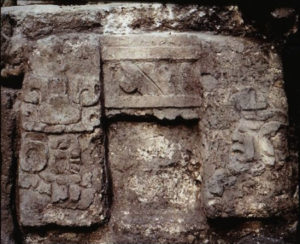
The Maya site of Blue Creek in northwestern Belize has been the focus of annual excavations and other investigations since 1992. This effort has produced a massive and important database for understanding the ancient Maya and for broader purposes in the field of archaeology. Most archaeological projects in Middle America are either focused on monumental architecture in the central area of an ancient city or deal with relatively small investigations of the settlement zone surrounding the central precinct of the site. This is generally a function of the limitations on time and funds available for fieldwork and data collection. By contrast, Blue Creek is an exceptional situation as the site has been the focus of on-going, multi-institutional, multi-national and multi-disciplinary research…and will continue to be so well into the future.
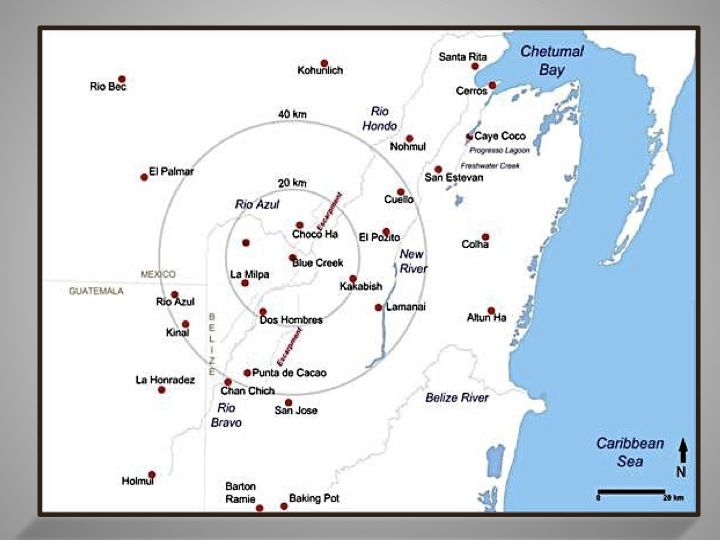 Location of Blue Creek in Northwestern Belize
Location of Blue Creek in Northwestern Belize
____________________________________________________________________________________________________________________
Blue Creek is a medium sized Maya center that was occupied from approximately 600BC until approximately AD 1000. Spatially, the “greater” Blue Creek area covers approximately 150 square kilometers. At first appearance, Blue Creek’ central precinct is unexceptional: surrounding its main plaza are 15 meter tall public buildings…but not large by Maya standards. However, just under the surface of Blue Creek, there are surprises to be found.
_________________________________________________________________________________________
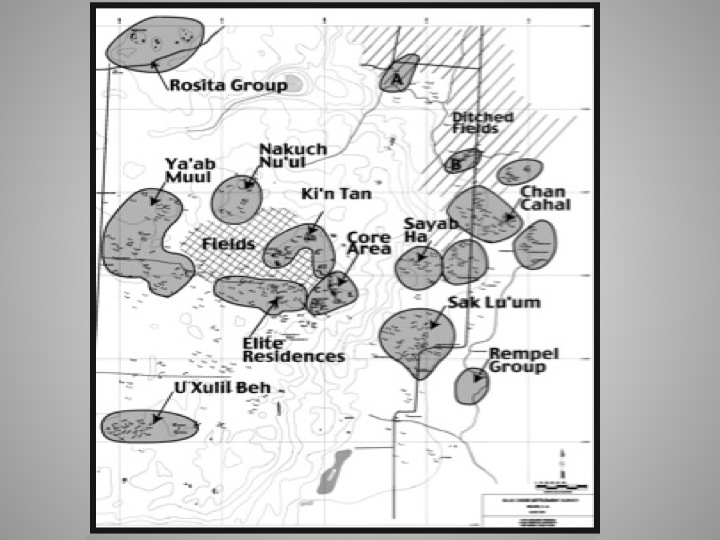 Blue Creek Site Core and Residential Zones
Blue Creek Site Core and Residential Zones
_____________________________________________________________________________________________________________________
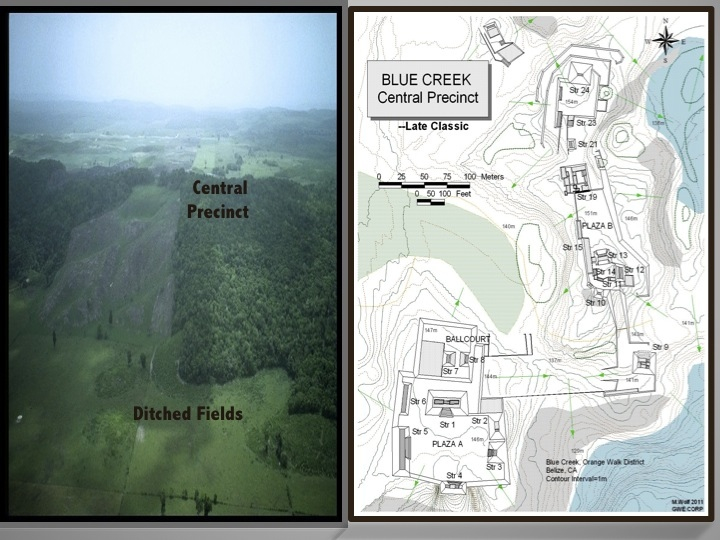
Blue Creek Central Precinct
_____________________________________________________________________________________________________________________
By the end of the Late Preclassic period (AD 150-250) and through the Early Classic period (AD 250-600), Blue Creek became a wealthy polity. To the Maya and to scholars who study the Maya, this means “jade”. Jade, or more properly, jadeite and nephrite, were the most precious stones in the Maya world. The largest caches of jade in the Maya world come from one of the largest cities (Tikal and Calakmul), a city near the source (Copan), and a palace of one of the most powerful royal families (Cancuen). However, it was perplexing to discover that the Maya world’s 5th largest cache of jade came from the medium sized city of Blue Creek.
Deeper investigations revealed that Blue Creek’s wealth derived from two equally important factors. The first is the presence of some of the richest and most extensive agricultural soils in Central America. The Blue Creek community covered approximately 150 square kilometers and more than half was used for agriculture. We have found several kinds of agricultural systems at Blue Creek, ranging in size and importance from small, household kitchen gardens to very large scale production systems such as large scale upland non-irrigated farming and lowland drained field farming. Blue Creek could and did produce far more agricultural products than needed by its population.
The central precinct of Blue Creek straddles a 100 meter escarpment that divides the low coastal plain from the karstic hills of the uplands. Above and west of the escarpment, the terrain is a mixture of eroded limestone hills separated by large expanses of clayey soils that today are prized by modern large-scale farmers. These “bajos” and “bajitos” range in size from 1 to 40 square kilometers. Moreover, below the escarpment are equally rich soils, but these were subject to seasonal inundation that could easily lead to complete crop losses. To prevent this, the Blue Creek Maya dug hundreds of kilometers of ditches to drain these fields. Our ongoing studies of these fields indicate that they were dug in the Early Classic period and maintained until the abandonment of Blue Creek in the Terminal Classic period. We also know that a wide variety of crops for food and other purposes were grown. For instance, there is considerable pollen and phytolith evidence for cultivation of fruit trees, including breadnut (Brosimum alicastrum), craboo or cha (Byrsonima species), caimito, agya, or sebul (Chrysophyllum species), chicle macho, chiquibul or chicle (Manilkara species), cacao (Theobroma cacao) or mountain cacao (T. bicolor), and avocado (Persia). At least one species of Marantaceae, probably platanillo (Pleiostachya pruinosa) or wild banana (Stromanthe hjalmarssonii), was also cultivated. Additionally, maize (Zea mays) and sweet potato (Ipomoea) pollen have been recovered.
Beyond Blue Creek’s ability to grow food and other agricultural products, the second factor for its economic success was its extraordinary access to other markets due to trade. Archaeologists have known for many years that Maya coastal trade in elite reinforcing exotic goods was active throughout the Classic period. We now believe that Maya trade canoes filled with food and other commodities virtually circumnavigated the Yucatan Peninsula and penetrated into the interior via rivers. Blue Creek is located at the terminus of the Rio Hondo, the northern-most river draining into the Caribbean Sea. Canoes filled with goods could reach the Caribbean in only three days. Then, goods could be loaded onto larger and deeper seagoing canoes bound for cities in the north that had less agricultural potential and higher risk of crop failure due to weather. Equally important, canoes coming from the Caribbean into the interior would have to stop at Blue Creek to off-load goods. From Blue Creek, these goods would be taken overland into the Petén sites such as Tikal and Uaxactun. Thus, Blue Creek’s economic success was also made possible because it was situated at a critical location on the trade network. Blue Creek’s gateway setting also facilitated the distribution of its own agricultural products. MRP has found a dock and related facilities at Blue Creek and similar features have also been found downstream at the site of Nohmul.
Sequence of Events at Blue Creek during the Classic Period
A distinct order had established itself at Blue Creek during the Early Classic period and was legitimized by the presence of innovative and symbolically charged forms of architecture. During the Early Classic, Plaza A was surrounded by ritual and multifunctional structures on three sides — leaving an open view of the agricultural fields and settlements off the escarpment to the east. Structure 1, the earliest documented columnated superstructure in the Southern Lowlands, dominates this plaza. In addition, a ballcourt was built on a separate platform immediately north of Plaza A.
________________________________________________________________________________________
 Plan View of Blue Creek Site Core during the Early Classic
Plan View of Blue Creek Site Core during the Early Classic
_____________________________________________________________________________________________________________________
In the Early Classic, Plaza B is dominated by the royal palace and is flanked to the north and south by temple pyramids. The most notable is Structure 9, a typical Peten style temple with a single room superstructure positioned atop a steeply inclined substructure with a central staircase and stair-side outsets. In the Early Classic, the facade of Structure 9’s outset near its summit was adorned with a five paneled, medium relief stucco frieze depicting a set of ahau images. This popul na—an ascension house for rulership—was not only the geographical center of the site but also served as its axis mundi.
_________________________________________________________________________________________
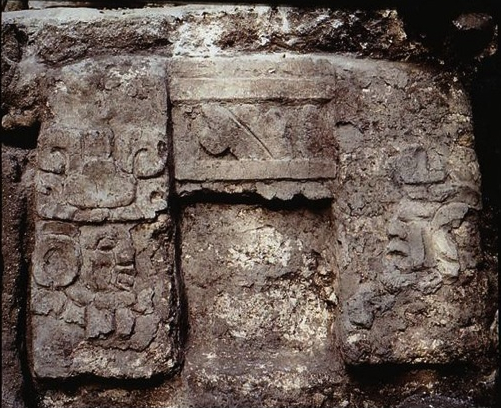 Structure 9 Masks
Structure 9 Masks
_____________________________________________________________________________________________________________________
Blue Creek’s sociopolitical structure changed significantly during the sixth century. A massive caching event occurred at approximately A D 550 at Structure 4 on Plaza A. In preparation of the ritual, a large part of the penultimate stage of Structure 4 was removed and a masonry-lined shaft was constructed. Numerous caches were placed around this shaft, including more than 100 vessels. Within the shaft itself, the artifacts recovered included nearly 9 pounds of worked jades (the fifth largest cache of jade recovered in Meoamerica), shells, and a chert eccentric. The shaft was capped with a massive limestone banner stone and an uncarved stelae. After this event, the flow of jade and other imported items into Blue Creek decreases dramatically.
________________________________________________________________________________________
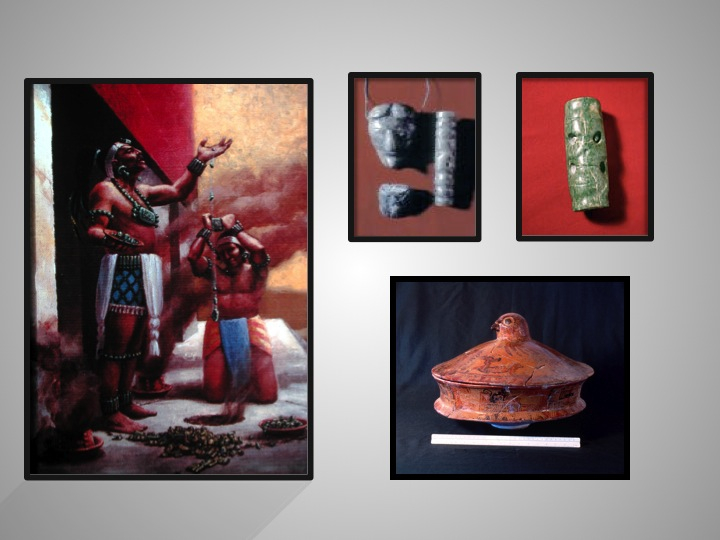 Jade Cache Event
Jade Cache Event
_____________________________________________________________________________________________________________________
The Late Classic political reorganization is reflected in the construction activities within the site core. In the early part of the Late Classic Structure 9 was razed and reoriented. This new phase of construction reoriented the structure 180 degrees and covered the Early Classic stucco frieze. Across the Main Plaza, the columnated superstructure of Structure 1 was razed and a flat superstructural platform was built to accommodate the tomb of an important member of the Blue Creek community. During this same period, Structures 2 and 3 were constructed, enclosing the eastern portion of Plaza A.
________________________________________________________________________________________
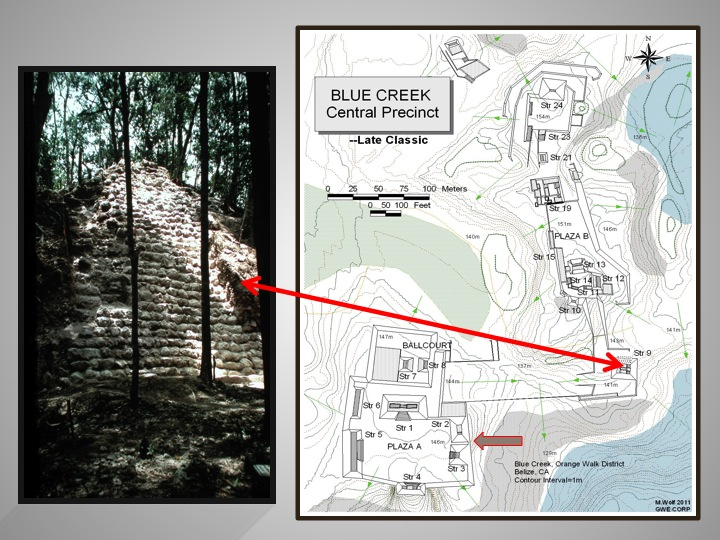 Structure 9 in the Late Classic
Structure 9 in the Late Classic
_____________________________________________________________________________________________________________________
The Structure 19 Courtyard – the residence of one of Blue Creek’s most powerful elite families–was also expanded during the Late Classic. During the Early Classic, access to the courtyard was easily obtained from Plaza B by a direct and open route. However, after a series of Late Classic structural additions and alterations, access became quite tortuous and convoluted, requiring one to navigate a number of passageways and rooms before one could enter either courtyard. In its final Late Classic form, the complex consists of a low platform upon which are at least fourteen interconnected rooms and passageways surrounding two very private courtyards.
________________________________________________________________________________________
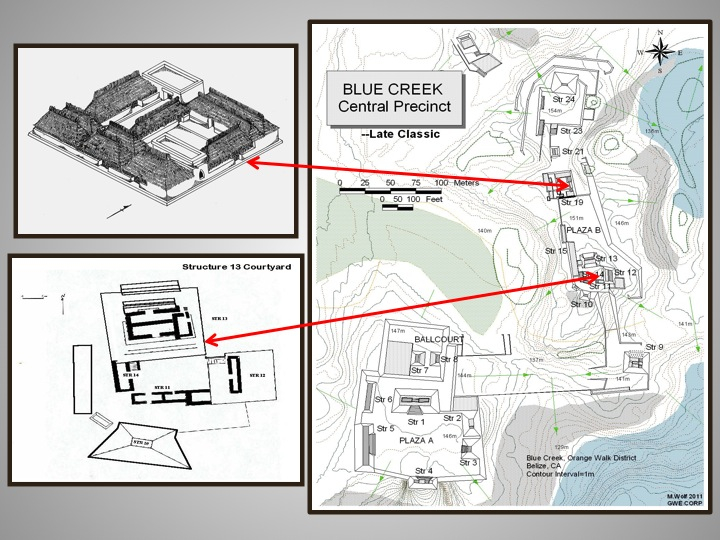 Palaces in the Late Classic
Palaces in the Late Classic
_____________________________________________________________________________________________________________________
Dramatically unlike the Structure 19 Courtyard, the Structure 13 Courtyard was not originally constructed as an elite residential group. Instead, its original, Early Classic function was as an open, public, triadic group. At the beginning of the Early Classic the group was composed of two temples: Structure 13 on the north side and Structure 12 on the east side. Later during the Early Classic, the plaza platform was expanded laterally to the west and Structure 10 was added to the complex. At the end of the Late Classic, Structures 12 and 14 were added. As a result, the plaza was transformed from sacred space to a secular, residential space.
During the Late Classic period significant population growth is noted at Blue Creek. In addition to the expansion of the elite residences within the site core, it was during the Late Classic period that 85% of the construction activities occurred within Kin Tan—a series of 9 elite residences directly west of the site core. Such residential expansions, both above and below the escarpment, occurred in proximity to high quality agricultural lands. One notable exception is U Xulil Beh. This low status residential group was constructed solely in the Late Classic in a marginal agricultural setting with poor agricultural potential. It is likely that existing communities already held power over the more productive lands forcing the inhabitants of U Xulil Beh to occupy these less productive agricultural fields.
_______________________________________________________________________________________
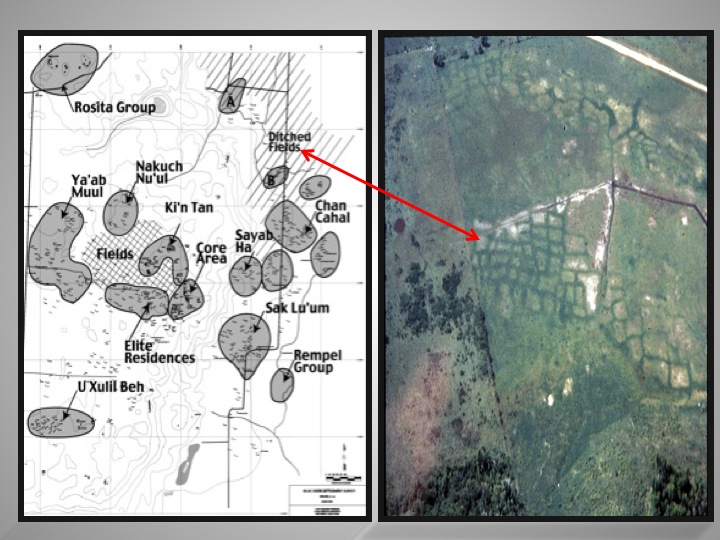 Residential Areas and Ditched Fields of Blue Creek
Residential Areas and Ditched Fields of Blue Creek
_____________________________________________________________________________________________________________________
The amount of land under cultivation peaked during the Late Classic. The large ditched agricultural systems below the escarpment had been in place for several hundred years. However, growing platforms were built at the base of the escarpment near the ditched fields to expand the amount of productive land. West and above the escarpment, the bajos separating residential components had also been cultivated for generations. In the Late Classic, however, terracing and cross-drainage features were built to expand the amount of arable land. Despite the high energetic effort placed into the construction of these features, they expanded Blue Creek’s agricultural potential by less than five percent. The amount of arable land within Blue Creek—at least 40% of the site’s total 150 square km area- was more than adequate for subsistence agriculture—even for this growing population. However, recent research has revealed that one factor that may have contributed to the need for expansion was that significant productivity was being lost to soil erosion and the quality of the soils was declining.
By the Terminal Classic, Blue Creek’s political structure had been dramatically and negatively transformed. Construction activities within the site core and adjacent residential areas, such as Kin Tan, had come to an abrupt halt. Ultimately, the Terminal Classic is marked by the abandonment and termination of sacred structures – both within the site core and within its most elite residences.
In the central precinct, large quantities of broken ceramics and other portable goods were deposited on the front of a shrine associated with Structure 3. This represents the final cultural event within the site core and the central precinct was subsequently abandoned.
During this same period, large deposits of broken ceramics and broken portable objects such as manos, metates, obsidian blades, and bifaces were deposited against the baseline of buildings within the Structure 13 Courtyard. In addition, smaller terminal deposits have been recovered from the Structure 19 Courtyard. Again, these deposits mark the final cultural event within these palace complexes and these groups too were subsequently abandoned.
Also during the Terminal Classic, large amounts of broken ceramics and portable goods were deposited against the baselines of buildings within Kín Tan. Within the Structure 37 Plazuela, dense deposits were recovered from the baseline of 3 of the group’s 7 structures – including this group’s sacred ancestral shrine – Structure 34. The artifacts recovered included over 22,000 sherds – weighing 393 kilograms. Intermixed with these broken vessels were 203 special finds – such as broken bifaces, manos, metates, obsidian blades, and figurines.
________________________________________________________________________________________
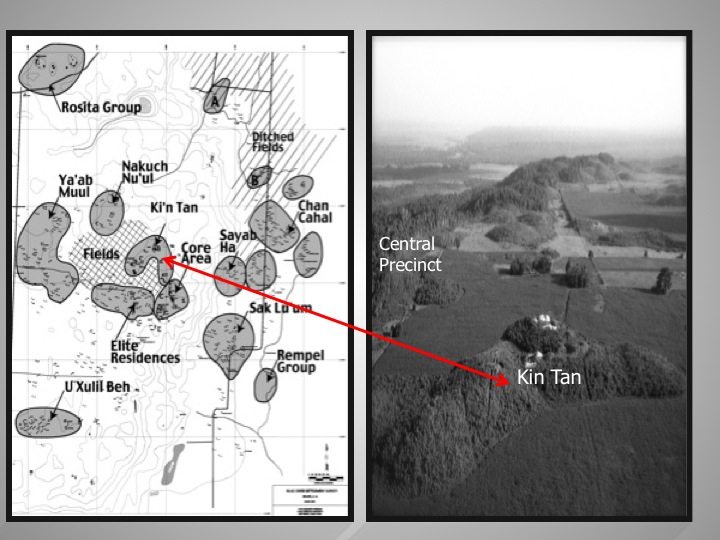 Kin Tan Plan View
Kin Tan Plan View
____________________________________________________________________________________________________________________
Within the Structure 47 Courtyard, a large deposit was also recovered from its centrally placed ancestral shrine—Structure 50. All told over 15,000 sherds weighing 349 kilograms were recovered from the northwest corner of the shrine. Intermixed with these broken vessels were 28 special finds – such as broken bifaces, manos, metates, obsidian blades, and beads. In addition, a deposit was recovered from the J14 Courtyard and shares the same characteristics of the other residential deposits. As within Blue Creek’s central precinct and palace complexes -these deposits mark the final cultural event within Kin Tan and the residential group was subsequently abandoned.
_________________________________________________________________________________________
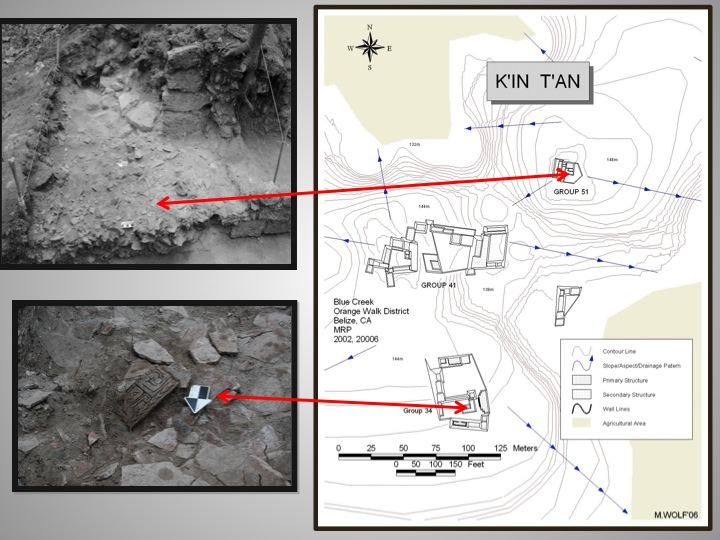 Special Deposit from Structure 50
Special Deposit from Structure 50
_____________________________________________________________________________________________________________________
While construction activities within the site core and adjacent elite residences comes to a halt at the end of the Late Classic and are terminated and abandoned during the Terminal Classic, there are some small-scale construction activities approximately 3.5 kms northwest of the central precinct in the residential group known as Rosita.
________________________________________________________________________________________
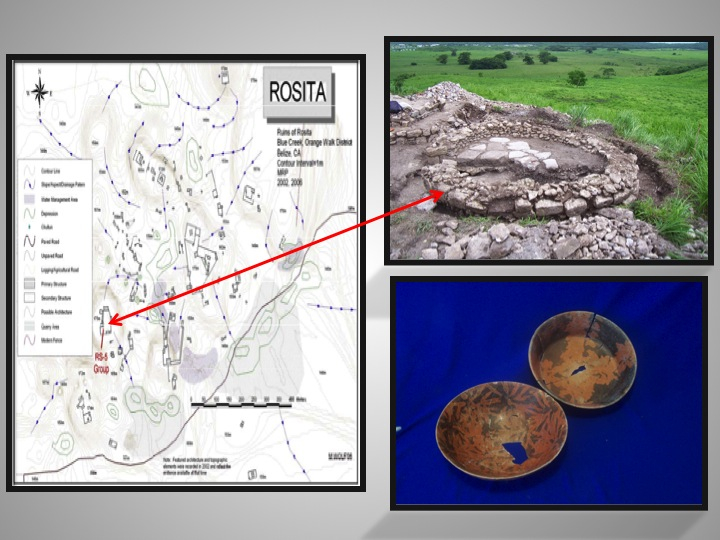 Plan View of Rosita
Plan View of Rosita
_____________________________________________________________________________________________________________________
Rosita consists of at least twenty structures built from Late Preclassic to the Classic. In one group, a residential room was razed during the Terminal Classic and replaced with a Yucatecan style shrine. However, this was a makeshift construction that involved stripping the masonry façade from the major building in the group. At approximately the same time, a set of rooms was added to the summit of Structure 6. Two Daylight Orange: Darknight Variety vessels were cached beneath the floor of this superstructure. In addition, a third Terminal Classic Daylight Orange cache was recovered in a bench in the nearby Structure 9. These caching events mark the final cultural event within this group. Soon thereafter, Rosita was abandoned as well.
Despite extensive testing throughout the settlement zone of Blue Creek over the past 20 years, we only have minor evidence of Postclassic occupation. Ceramics recovered from the surface of Structure U-5, at the base of the escarpment, and from the Rempel Group on the bank of the Rio Bravo, indicate that a small residual population still occupied the area (Figure 13: Postclassic at Blue Creek). These people may have exploited remnant orchards that would have survived with minimal human intervention in the nearby ditched field systems. However, evidence from the Birds of Paradise Fields indicate that by 1100 AD even this small residual population had abandoned the area and the ditched fields that had been maintained for generations had in-filled.
________________________________________________________________________________________
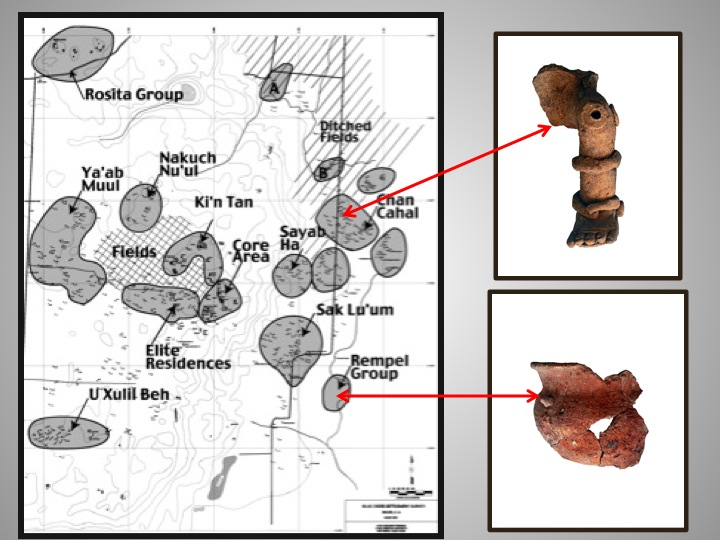 Postclassic at Blue Creek
Postclassic at Blue Creek
____________________________________________________________________________________________________________________
How You Can Participate at Blue Creek
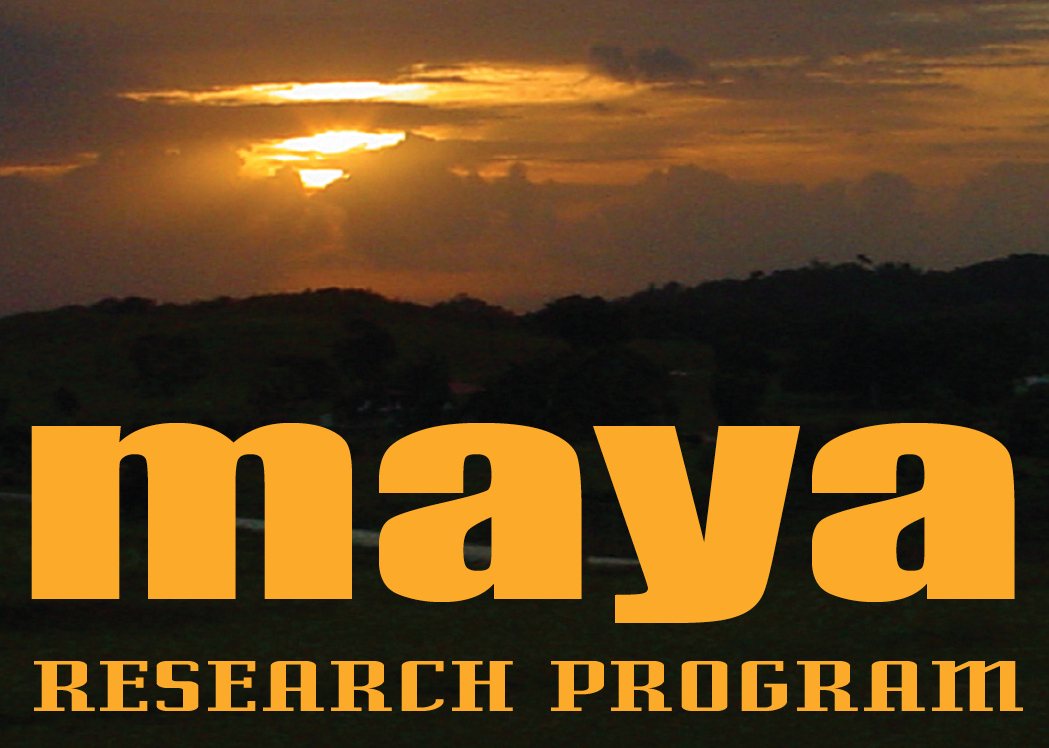 The Maya Research Program (MRP) is a U.S.-based non-profit organization (501c3) that sponsors archaeological and ethnographic research in Middle America. Each summer since 1992, MRP has sponsored archaeological fieldwork at the ancient Maya site of Blue Creek in northwestern Belize and ethnographic research in the village of Yaxunah, Mexico. The Blue Creek Archaeological Project is an annual excavation that incorporates cost-sharing volunteers and students. In 2012, MRP continues to offer students and volunteers opportunities to participate in one of the major research efforts in Maya archaeology. The Blue Creek project is open to student and non-student participants, regardless of experience. Participants will receive training in both excavation and laboratory techniques and receive a “crash course” on the Maya and archaeological methodology. The Blue Creek field school is certified by the Register of Professional Archaeologists.
The Maya Research Program (MRP) is a U.S.-based non-profit organization (501c3) that sponsors archaeological and ethnographic research in Middle America. Each summer since 1992, MRP has sponsored archaeological fieldwork at the ancient Maya site of Blue Creek in northwestern Belize and ethnographic research in the village of Yaxunah, Mexico. The Blue Creek Archaeological Project is an annual excavation that incorporates cost-sharing volunteers and students. In 2012, MRP continues to offer students and volunteers opportunities to participate in one of the major research efforts in Maya archaeology. The Blue Creek project is open to student and non-student participants, regardless of experience. Participants will receive training in both excavation and laboratory techniques and receive a “crash course” on the Maya and archaeological methodology. The Blue Creek field school is certified by the Register of Professional Archaeologists.
If you are interested joining the team in 2012 (or beyond), we offer four two-week sessions in each summer. We invite students and volunteers to participate in the Maya Research Program’s 21st year of our Blue Creek Archaeological Project in Belize.
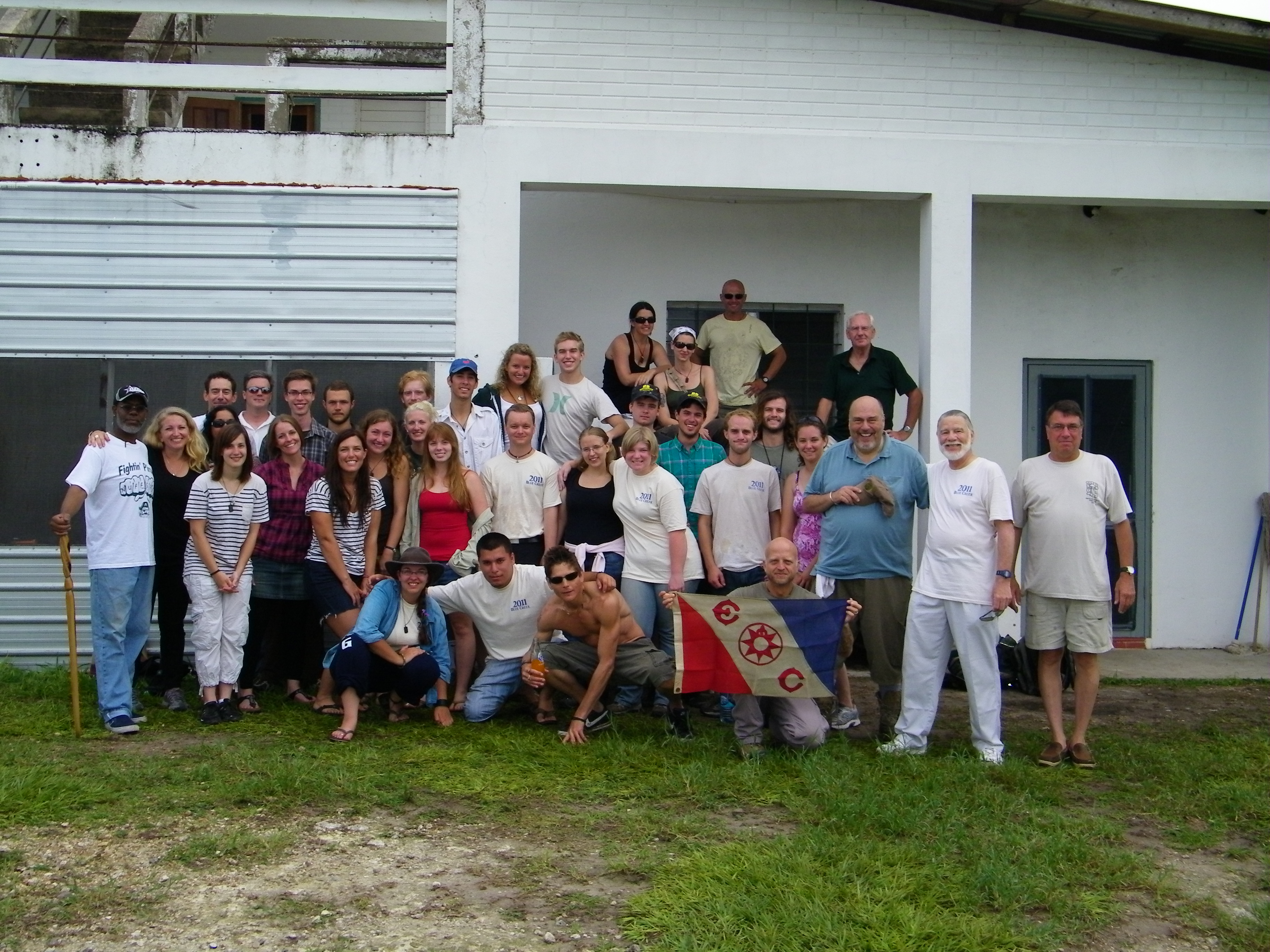 2011 Students and Volunteers and Explorer’s Club Flag Expedition
2011 Students and Volunteers and Explorer’s Club Flag Expedition
2012 Field Season Dates:
Session 1: Monday May 28 – Sunday June 10;
Session 2: Monday June 11 – Sunday June 24 ;
Session 3: Monday July 2 – Sunday July 15;
Session 4: Monday July 16 – Sunday July 29
If you have any questions or would like additional information please contact the Maya Research Program:
www.mayaresearchprogram.org
1910 East Southeast Loop 323 #296
Tyler, Texas 75701
817-831-9011
[email protected]



